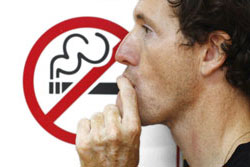Introduction to smoking
Even though smoking carries serious health risks, a significant proportion of the Australian population (21%) continues to smoke. Many smokers attempt to quit at some stage, and each year many individuals choose quitting smoking as one of their New Year’s Resolutions. Despite resolving to quit, many people find it a difficult process because the nicotine contained in tobacco is a highly addictive substance.
Getting help such as counselling and support from a health professional (e.g. your GP) can increase an individual’s chance of successfully quitting smoking. It’s also important for individuals to psych themselves up for the challenge of quitting and be motivated to achieve their goal; individual motivation is a key factor influencing the ability to quit. The New Year provides individuals with additional motivation to make resolutions to improve their health, so this New Year, why not quit smoking?
Risks of tobacco smoking
Tobacco smoke contains many toxic chemicals. Smoking tobacco is associated with many serious health risks resulting from exposure to these chemicals. It is responsible for some 12% of Australia’s disease burden, and around 19,000 deaths are attributable to tobacco smoking in Australia each year.
Health risks associated with tobacco smoking include:
- Increased risk of numerous cancers, most prominently lung and mouth cancers;
- Increased risk of oral and dental conditions (e.g. gum disease and dental implant failure);
- Heart disease;
- Stroke;
- Lung disease (e.g. emphysema);
- Adverse effect on foetal development if a pregnant woman smokes;
- Environmental tobacco smoke adversely affects the health of children and adults exposed to it;
- Increased risk of eye conditions;
- Negative effects on skin (e.g. more wrinkles);
- Reduced sperm quality and quantity; and
- Increased risk of infertility.
Why quit smoking?
Quitting smoking is likely to save you considerable sums of money, and will also improve your overall health. Quitting significantly reduces the risk of health conditions associated with smoking. For example:
- The risk of coronary heart disease reduces by half one year after quitting smoking;
- The risk of lung cancer reduces by half ten years after quitting smoking;
- The risk of dying from all smoking-related causes is reduced to the same level as for a non-smoker 15 years after quitting.
 |
Have you quit smoking? Or are thinking about trying to quit? Use this tool to see what health benefits you have already achieved and what benefits you can expect in the future if you stick with it. For more information, see Health Benefits of Quitting Smoking Tool. |
Tips to help quit smoking
It is a good idea to talk to a doctor about quitting smoking. Doctors usually ask their patients whether or not they smoke when they visit for other health treatments and check-ups, so that they can offer information and support to individuals who wish to quit. Doctors can also monitor an individual’s progress with quitting (e.g. checking how they are progressing each time they visit the clinic), which might provide additional motivation; and can provide prescriptions for medications that can help quit smoking.
In addition to speaking to a doctor, individuals who have resolved to quit smoking in the New Year can prepare by:
- Making a date for quitting;
- Being motivated about quitting;
- Thinking about the reasons why they smoke and writing them down. They may include:
- Emotional reasons (e.g. stress or depression);
- For pleasure, to relax or as a reward for achievements;
- Social or peer pressure;
- Habit (e.g. smoking while doing certain things like driving or having a cup of coffee);
- Nicotine cravings;
- Writing down some strategies that may be used to cope in difficult times after quitting;
- Obtaining professional advice and written material about strategies for quitting smoking. GPs and pharmacists can usually provide advice and written information, but busy individuals may find it easier to use a free telephone counselling service such as Quitline;
- Making a list of reasons for quitting. This can be read several times a day for motivation.
When attempting to quit, smokers should:
Surround themselves with supportive people, as this will increase the chance of quitting in the long term;
- Be prepared for quitting being difficult, especially in the first few weeks. Take it day by day and congratulate themselves for every day they remain smoke free;
- Spend time with non-smoking friends and go to non-smoking places (e.g. shopping centres, cinemas);
- Consider joining an intensive quit smoking program;
- Consider using nicotine replacement, as this therapy increases the likelihood of an individual quitting smoking. Some people may wish to try nicotine replacement therapy if they are having trouble quitting;
- Introduce smoking restrictions in their homes (e.g. ask other people to smoke outside). Introducing household smoking restrictions can help smokers to quit;
- Delay acting on the urge to smoke. It will usually resolve in about five minutes;
- Do something else when they feel like smoking, even if it is just drinking a glass of water or breathing deeply;
- Break their routine, and pay particular attention to breaking routines that used to involve smoking (e.g. if they used to smoke when drinking coffee or beer, try abstaining from these beverages for a while). Doing some morning exercise to replace time previously spent smoking in the morning may also be useful;
- Calculate how much money they have saved by quitting smoking, and spend it on something nice;
- Not be too disappointed if they slip up. Many people find it difficult to quit smoking and may find themselves having “just one” cigarette. Don’t consider slip ups as failures, but rather continue attempting to quit after a slip up;
- Find a friend to give up smoking with, for mutual support and motivation;
- Not shop at the place they used to buy cigarettes;
- Get plenty of exercise.
More information
 |
For more information on smoking and its health effects, and some useful tools, videos and animations, see Smoking. |
 |
For more information on staying healthy in the New Year, including tips on diet, partying, exercise and general health, see Health in the New Year. |
References
- Australian Government Department of Health and Ageing. Smoking cessation guideline for general practice [online]. 2004 [cited 16 December 2009]. Available from: URL link
- Bergström J. Cigarette smoking as risk factor in chronic periodontal disease. Community Dent Oral Epidemiol. 1989; 17(5): 245-7.
- Australian Cancer Council. Tobacco in Australia: facts and issues. Chapter 3: The health effects of active smoking [online]. 2008 [cited 22 August 2009]. Available from: URL link
- Lois N, Abdelkader E, Reglitz K, Garden C, Ayres JG. Environmental tobacco exposure and eye disease. Br J Ophthalmol. 2008; 92(10): 1304-10.
- Vine MF. Smoking and male reproduction: A review. Int J Androl. 1996; 19(6): 323-37.
- Cancer Council NSW. Preparing to quit [online]. 2009 [cited 16 December 2009]. Available from: URL link
- Cancer Council NSW. Quit tips [online]. 2009 [cited 16 December 2009]. Available from: URL link
- Cancer Council NSW. Getting help [online]. 2009. [cited 16 December 2009]. Available from: URL link
All content and media on the HealthEngine Blog is created and published online for informational purposes only. It is not intended to be a substitute for professional medical advice and should not be relied on as health or personal advice. Always seek the guidance of your doctor or other qualified health professional with any questions you may have regarding your health or a medical condition. Never disregard the advice of a medical professional, or delay in seeking it because of something you have read on this Website. If you think you may have a medical emergency, call your doctor, go to the nearest hospital emergency department, or call the emergency services immediately.


 Surround themselves with supportive people, as this will increase the chance of quitting in the long term;
Surround themselves with supportive people, as this will increase the chance of quitting in the long term;





